Collection of materials relating to neuro-ophthalmology as part of the Neuro-Ophthalmology Virtual Education Library.
NOVEL: https://novel.utah.edu/
TO
- NOVEL226
| Title | Creator | Description | Subject | ||
|---|---|---|---|---|---|
| 101 |
 |
Optical Coherence Tomography Angiography | David Zhao; Amanda Henderson, MD | Video presentation covering a thorough overview of Optical Coherence Tomography Angiography (OCTA). | Optical Coherence Tomography Angiography; OCTA |
| 102 |
 |
Introduction to Diagnostic Testing: Audio-Vestibular | Daniel R. Gold, DO | Introduction to the audio-vestibular diagnostic testing section of the NExT curriculum. | Diagnostic Testing; Exams; Audio-Vestibular |
| 103 |
 |
Ocular Lateropulsion Left AICA Stroke | Jorge C Kattah, MD | 82 year-old patient with basilar artery stenosis, she developed an acute left AICA stroke. On examination within 24 hours from symptom onset, she had primary gaze, unidirectional, right beat nystagmus and a positive left head impulse test. Brief periods of eyelid closure were associated with a h-... | Ocular Lateropulsion; AICA Stroke |
| 104 |
 |
Temporal Artery Biopsy Procedure | Nooran Badeeb; Danah Albreiki | Temporal artery biopsy is a procedure that is done in a patient with suspicion of GCA (Giant cell Arteritis), and some of the clinical manifestations that prompts us to suspect the diagnosis in patients older than 50 years old are: 1. GCA symptoms e.g. new onset headache. 2 . Visual symptoms: - Visi... | Temporal Artery Biopsy; GCA; Temporal Arteritis |
| 105 |
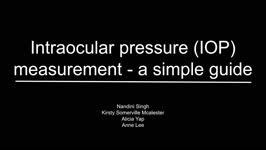 |
Intraocular Pressure (IOP) Measurement: A Simple Guide | Nandini Singh; Kirsty Sumerville Mcalester; Alicia Yap; Anne Lee | This video demonstrates the technique for measuring intraocular pressure (IOP) and the use of the tonopen. | Intraocular Pressure (IOP); Tonometry |
| 106 |
 |
Selective Saccadic Palsy After Cardiac Surgery | Nilan D. Schnure, MD; Ali G. Hamedani, MD, MHS; Grant T. Liu, MD | A unique gaze palsy selectively affecting saccades while sparing smooth pursuit, vergence, and vestibular reflex eye movements has been described following uncomplicated cardiac (and especially ascending aortic) surgery . This 69 year-old man reported persistent visual complaints immediately after a... | Saccade; Saccadic Palsy; Cardiac Surgery |
| 107 |
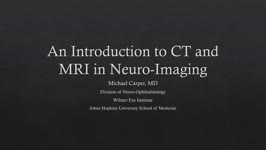 |
An Introduction to CT and MRI in Neuro-Imaging | Michael Carper, MD | A brief lecture covering basic neuro-imaging, including computed tomography (CT) and magnetic resonance imaging (MRI). | Computed Tomography (CT); Magnetic Resonance Imaging (MRI); Neuro-imaging |
| 108 |
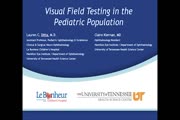 |
Visual Field Testing in the Pediatric Population | Lauren C. Ditta, MD | Visual field testing can be performed in the pediatric population with ease, however the proper technique for testing must be utilized and is tailored to each child's unique clinical situation and age. Confrontation visual field testing is a quick and easy; test that can yield a rough assessment of ... | Visual Field Testing; Pediatric; Confrontation Visual Field; Automated; Perimetry |
| 109 |
 |
Introduction to the Pupil Examination | Karl C. Golnik, MD | Introduction to pupil examination techniques. | Pupil Examination |
| 110 |
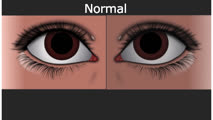 |
Normal Light Reflex and Relative Afferent Pupillary Defect (RAPD) | Marshall Huang, 4th Year Medical Student | A Relative Afferent Pupillary Defect is an examination finding in patients who have an asymmetric pupillary reaction to light when it is shined back and forth between the two eyes. It is most commonly a sign of asymmetric optic nerve disease or damage but can also present in widespread asymmetric r... | Light Reflex; RAPD |
| 111 |
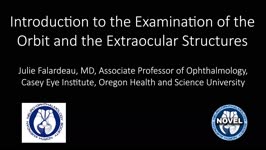 |
Introduction to Examination of the Orbit and the Extraocular Structures in NANOS NOTE | Julie Falardeau, MD | Introduction to Examination of the Orbit and the Extraocular Structures | Orbit; Anatomy |
| 112 |
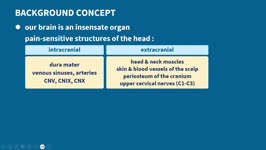 |
Headache Associated With Low or High Intracranial Pressure | Yu Hsin Chen; Amanda Dean Henderson; James Brian Davis | When intracranial pressure changes, the most common symptom is headache, which often has a positional component. We introduce various etiologies of headaches attributed to increased or low intracranial pressure, with idiopathic intracranial hypertension (or primary pseudotumor cerebri), post-dural p... | CSF Leak; Headache; Intracranial Hypertension; Intracranial Hypotension; Papilledema; Pseudotumor Cerebri |
| 113 |
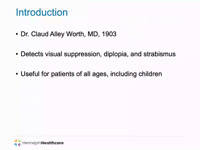 |
Worth 4-Dot Test | Angela Cao; Anne Abel | This presentation describes the Worth 4-Dot test, demonstrates how to perform the test, and interpret results. | Amblyopia; Diplopia; Worth 4-dot Test |
| 114 |
 |
NANOS Illustrated Curriculum Section D Introduction | Meagan D. Seay, DO; Victoria S. Pelak, MD | Introduction video to the resources available in Section D of the NANOS Illustrated Curriculum. | Lesions, Afferent Visual Pathway; Disorders, Afferent Visual Pathway; Pupillary Anatomy; Disorders, Pupillary Function; Lesions, Efferent Visual Pathway; Ocular Motility; Abnormal Eye Movements; Eyelids; Abnormal Facial Movements |
| 115 |
 |
NANOS Illustrated Curriculum Section G Introduction | Meagan D. Seay, DO | Introduction video to the resources available in Section G of the NANOS Illustrated Curriculum. | Obesity, Management; Low Vision, Management; Genetic Diseases, Management; Patient Counseling |
| 116 |
 |
Introduction to Ocular Examination | Ore-ofe Adesina, MD | Introduction to the Ocular Examination section of the NExT curriculum. | Exams; Ocular Examination |
| 117 |
 |
Introduction to the Neurological Examination in NANOS NOTE | Padmaja Sudhakar, MD | An introduction to the neurological examination. | Neurology; Neurological Examination |
| 118 |
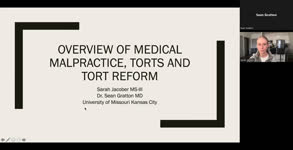 |
Overview of Medical Malpractice, Torts, and Tort Reform | Sarah Jacober; Sean Gratton | This is a brief narrated powerpoint, which serves as an introduction to the basics of medical malpractice. The definition and history of medical malpractice are explored. The relationship between medical malpractice and tort law are explained, and tort reform is introduced. | Lawsuit; Malpractice; Medical Malpractice; Medicolegal; Tort Reform; Torts |
| 119 |
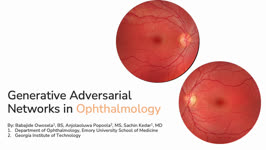 |
Generative Adversarial Networks in Ophthalmology | Babajide Olubusayo Owosela; Anjolaoluwa Popoola; Sachin Kedar | In this video we will describe Generative Adversarial Networks (GAN) models and its applications and limitations in Ophthalmology. GAN, a technique within machine learning, enables computers to utilize real data to generate valuable synthetic data, artificially produced information that mimics the s... | Artificial Intelligence; Generative Adversarial Networks; Machine Learning; Synthetic Data |
| 120 |
 |
Age Related Macular Degeneration | Riya H. Patel; James Brian Davis; Amanda Dean Henderson | Age-related macular degeneration (AMD) is a degenerative disease of the retina that causes central vision loss, and it is the leading cause of blindness in the developed world. Age is a strong nonmodifiable risk factor for AMD. Patients may have genetic susceptibility to AMD from mutations in genes ... | AMD; AREDS2; Exudative; Geographic Atrophy; Macular Degeneration; Nonexudative |
| 121 |
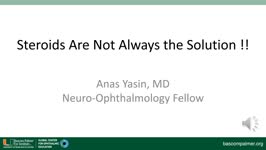 |
Steroids Are Not Always the Solution!! | Anas Yasin, MD | Leber Hereditary Optic Neuropathy (LHON) is the most common inherited mitochondrial disorder and typically affects young males. (https://eyewiki.aao.org/Leber_Hereditary_Optic_Neuropathy) | Leber Hereditary Optic Neuropathy (LHON) |
| 122 |
 |
Optic Tract Syndrome Secondary to Lacunar Infarction | Justin J. Grassmeyer, PhD; Kenan Xiao, MD; Jason T. Helvey, MD; Sachin Kedar, MD | Lesions of the optic tract produce a characteristic triad of clinical findings: contralateral homonymous hemianopia, contralateral relative afferent pupillary defect, and bilateral optic disc atrophy. This case describes clinical features, radiological findings, and optical imaging characteristics f... | Optic Tract Syndrome; Optic Tract; Lacunar Infarction; Homonymous Hemianopia |
| 123 |
 |
Practice Based Learning and Improvement (PBLI) | Karl C. Golnik, MD, MEd | Video describing methods and best practices of Practice Based Learning and Improvement (PBLI). | Practice Based Learning and Improvement (PBLI) |
| 124 |
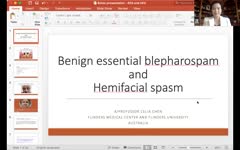 |
Benign Essential Blepharospasm and Hemifacial Spasm | Celia Chen, MBBS, PhD, FRANZCO | Narrated lecture on treatment of benign essential blepharospasm and hemifacial spasm. | Benign Essential Blepharospasm; Hemifacial Spasm |
| 125 |
 |
Maintenance of Certification Basics: American Board of Psychiatry and Neurology | Sean Gratton, MD | Video lecture covering certification basics. | Credentialing |
